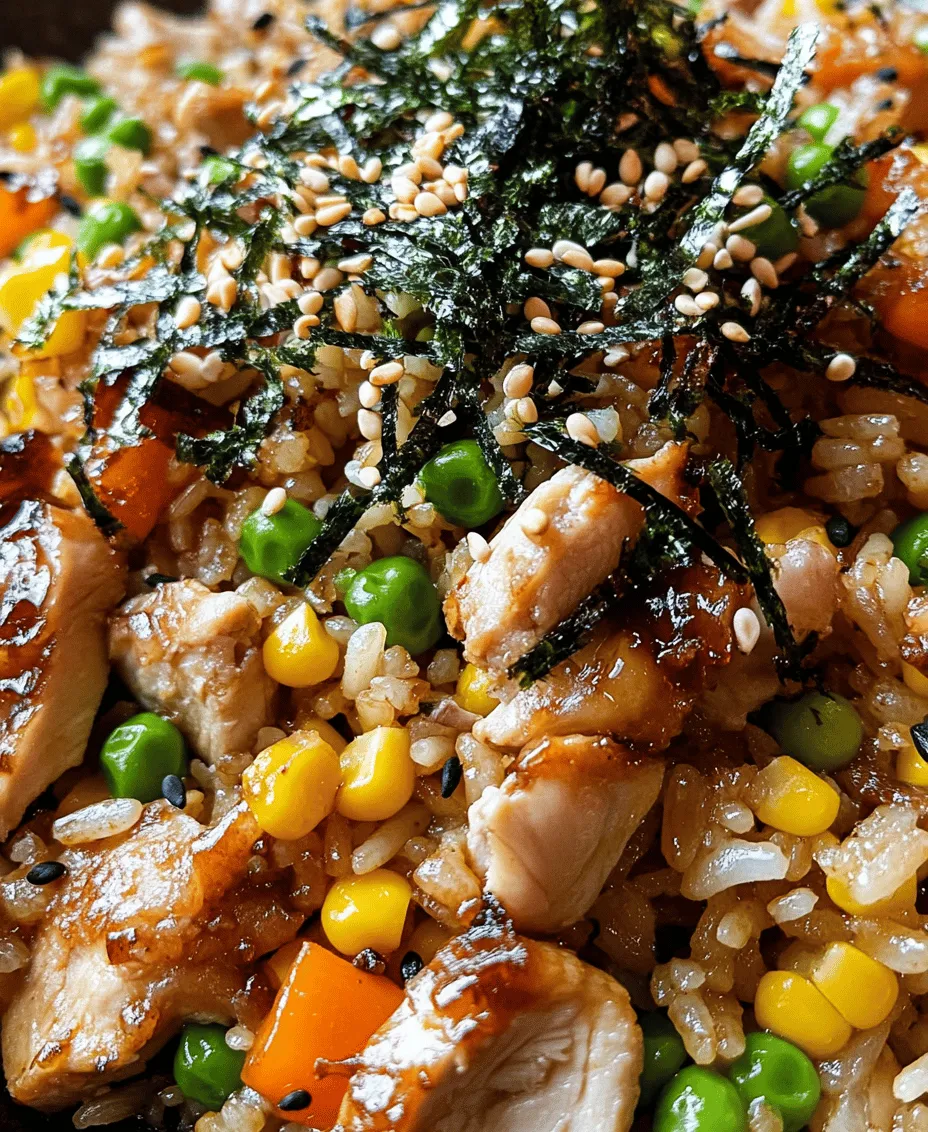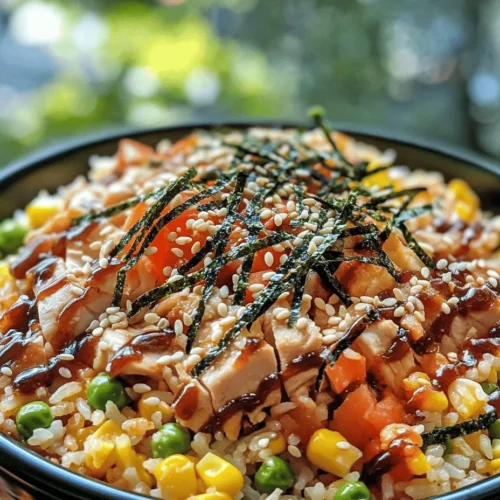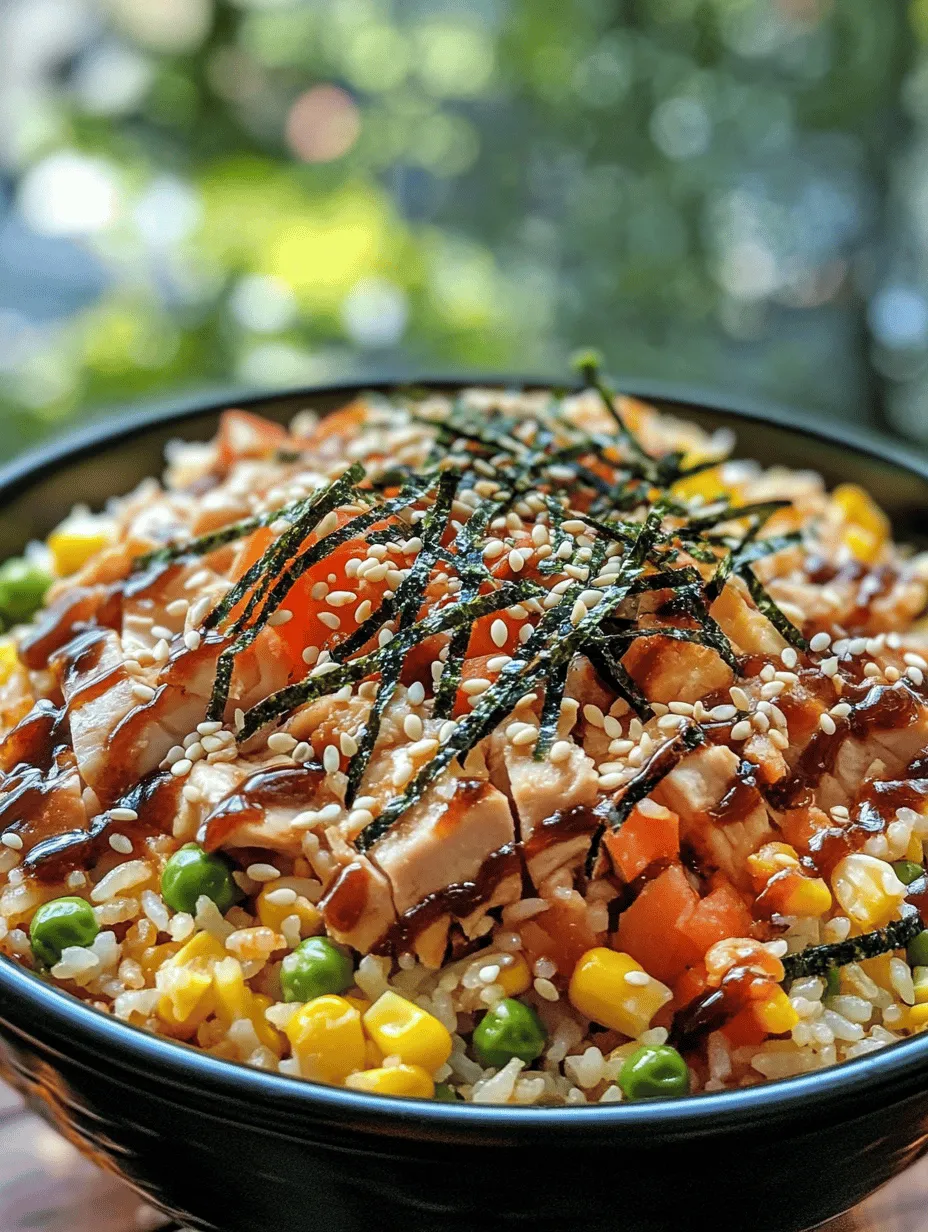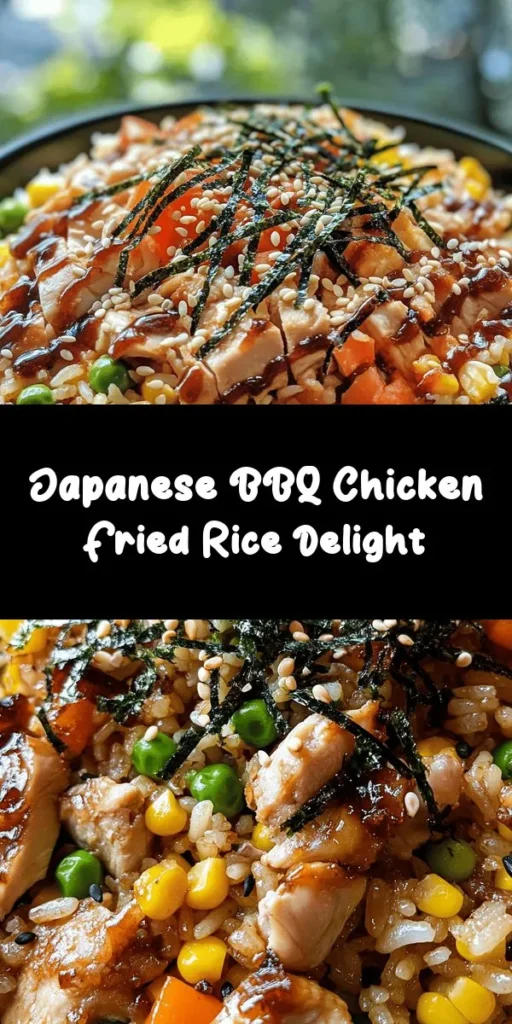Introduction
Japanese cuisine has gained a significant following around the world, and for good reason. Its emphasis on fresh ingredients, beautiful presentation, and a harmonious balance of flavors has captivated food lovers globally. From sushi to ramen, Japanese dishes showcase a unique culinary art that reflects both tradition and innovation. Among these delightful offerings is a dish that stands out for its comforting appeal and robust flavors: Savory Japanese BBQ Chicken Fried Rice.
This dish is not just a simple fried rice; it’s an extravagant mix of marinated chicken, vibrant vegetables, and perfectly cooked rice, all stir-fried to create a satisfying meal that tantalizes the taste buds. The combination of savory BBQ flavors with the comforting texture of fried rice makes it a favorite for both casual weeknight dinners and festive occasions.
One of the secrets to achieving the perfect fried rice lies in the choice of rice itself. Day-old rice, in particular, is a game-changer when it comes to texture. Freshly cooked rice tends to be too moist and can become mushy when stir-fried. In contrast, day-old rice has had time to cool and dry out, resulting in distinct grains that hold up beautifully during cooking. This is a crucial tip that will elevate your fried rice experience, ensuring that each bite is flavorful and satisfying.
Understanding the Core Ingredients
To create a truly magnificent Savory Japanese BBQ Chicken Fried Rice, it’s vital to understand the core ingredients that contribute to its rich flavor and texture. Each component plays a significant role in the overall success of the dish, so let’s break them down.
Essential Ingredients
1. Rice: The foundation of any fried rice dish is, of course, the rice itself. For this recipe, both jasmine rice and sushi rice are excellent choices. Jasmine rice offers a subtle floral aroma and a slightly sticky texture, making it ideal for fried rice. Sushi rice, on the other hand, is short-grained and sticky, which helps the grains clump together and absorb flavors. Both types will deliver a delicious result, but it’s essential to choose the one that best suits your taste preference.
2. Boneless, Skinless Chicken Thighs: While you might be tempted to use chicken breasts for their lean profile, boneless, skinless chicken thighs are the star of this dish. Thighs are richer in flavor, juicier, and more forgiving in terms of cooking; they won’t dry out as easily as breasts. This additional moisture ensures that every bite of chicken is tender and flavorful, making it an ideal choice for stir-frying.
3. Soy Sauce, Mirin, and Sake: To achieve that authentic Japanese taste, incorporating these three ingredients is paramount. Soy sauce adds depth and saltiness, mirin contributes a subtle sweetness and glossy finish, while sake enhances the overall umami profile. This trifecta of flavors is essential for marinating the chicken and seasoning the rice, creating a well-rounded dish that’s bursting with flavor.
4. Fresh Vegetables: Incorporating a variety of fresh vegetables not only enhances the nutritional value of your fried rice but also adds a vibrant splash of color. Common choices include peas, carrots, bell peppers, and green onions. These ingredients provide a range of textures and flavors, ensuring that each bite is exciting and satisfying.
Marinating the Chicken: Elevating Flavor
One of the most critical steps in preparing Savory Japanese BBQ Chicken Fried Rice is marinating the chicken. This process not only infuses the meat with flavor but also helps to tenderize it, resulting in juicy, succulent pieces of chicken that enhance the overall dish. Here’s a step-by-step guide to marinating the chicken thighs:
Step 1: Prepare the Marinade
In a bowl, combine the following ingredients to create a flavorful marinade:
– Soy Sauce: 3 tablespoons
– Mirin: 2 tablespoons
– Sake: 2 tablespoons
– Fresh Ginger: 1 tablespoon, grated
– Garlic: 2 cloves, minced
– Sesame Oil: 1 teaspoon (optional, for added depth)
Stir the mixture until well combined, ensuring that the ginger and garlic are evenly distributed throughout.
Step 2: Marinate the Chicken
Place the boneless, skinless chicken thighs in a resealable plastic bag or a shallow dish. Pour the marinade over the chicken, ensuring that each piece is thoroughly coated. Seal the bag or cover the dish with plastic wrap.
Step 3: Refrigerate
For optimal flavor absorption, let the chicken marinate for at least 30 minutes, although marinating for a few hours or even overnight will yield even better results. The longer the chicken sits in the marinade, the deeper the flavors will penetrate, resulting in a more delicious final product.
Step 4: Prepare for Cooking
Once marinated, remove the chicken from the refrigerator and allow it to come to room temperature for about 10-15 minutes before cooking. This step ensures even cooking and helps the chicken retain its juices.
Flavor Variations
While the basic marinade is excellent on its own, feel free to experiment by substituting proteins or adding spices. For a variation, try using sliced beef or tofu for a vegetarian option. You can also incorporate a pinch of red pepper flakes for a hint of heat or a splash of lime juice for a zesty twist.
Preparing the Rice: The Foundation of Fried Rice
As previously mentioned, the rice is the star of the show when it comes to fried rice dishes. To achieve the best texture and flavor, it’s critical to pay attention to how you prepare the rice.
Day-Old Rice: The Key to Success
Using day-old rice is recommended for several reasons. When rice is cooked and then allowed to cool, the grains firm up, making them less likely to stick together during the stir-frying process. This results in a light, fluffy fried rice rather than a clumpy mess.
If you don’t have day-old rice on hand, don’t worry! You can still achieve a good texture by cooking fresh rice and allowing it to cool. Spread the freshly cooked rice on a baking sheet in an even layer and let it sit at room temperature for about 30 minutes to cool down. If you’re in a hurry, you can also place it in the fridge for about 15 minutes; just make sure to keep it uncovered to prevent condensation.
Storing Cooked Rice
If you find yourself with leftover rice from a previous meal, storing it properly can make all the difference. To store cooked rice, simply transfer it to an airtight container and refrigerate it. It can typically be stored for up to four days. When you’re ready to use it, just take it out and cold stir-fry it directly from the refrigerator for the best results.
With these preparations in mind, you’re well on your way to creating a delicious Savory Japanese BBQ Chicken Fried Rice Extravaganza. The combination of marinated chicken, day-old rice, and fresh vegetables will come together to create a dish that is not only satisfying but also packed with authentic Japanese flavors. Stay tuned for the next part, where we’ll dive into the cooking techniques that will take your fried rice to the next level.

Importance of Using a Large Skillet or Wok
When it comes to preparing Savory Japanese BBQ Chicken Fried Rice, a large skillet or wok is essential. The ample surface area allows for even cooking and effective stir-frying, which are crucial for achieving that delightful texture and flavor that defines this dish. A large skillet or wok promotes high heat retention, ensuring that the ingredients cook quickly without steaming, which maintains their individual textures.
Using high heat allows the ingredients to sear and caramelize, enhancing the overall flavor profile of the fried rice. As you prepare, ensure that the skillet or wok is preheated adequately before adding the oil. This step is vital for achieving that signature crispy texture in the rice while preventing it from becoming soggy.
Detailed Instructions for Each Cooking Step
1. Preparation of Ingredients: Start by gathering all your ingredients. This includes pre-cooked chicken, day-old rice (preferably jasmine or short-grain rice), soy sauce, mirin, sesame oil, and your choice of vegetables. Having everything chopped and ready will help streamline the cooking process.
2. Cooking the Chicken: Heat your large skillet or wok over high heat and add a splash of vegetable oil. Once the oil shimmers, add your pre-cooked chicken. Stir-fry for about 3-5 minutes until heated through and slightly crispy on the edges. Remove the chicken from the skillet and set it aside, ensuring the pan retains its heat.
3. Sautéing the Aromatics: In the same skillet, add a bit more oil if needed, and toss in minced garlic and ginger. Stir-fry for about 30 seconds until fragrant, being careful not to burn them, as this will impart a bitter taste to your dish.
4. Sautéing Vegetables: Next, add your chopped vegetables. A combination of bell peppers, carrots, peas, and green onions works beautifully. Sauté for about 2-4 minutes, stirring frequently. You want the vegetables to remain crisp, so avoid overcooking. If you’re using harder vegetables like carrots, consider adding them first, allowing them a moment to soften before introducing more delicate veggies.
5. Combining Ingredients: Once the vegetables are done, push them to the side of the skillet to create space for the rice. Add the day-old rice, breaking up any clumps with your spatula. Pour in the soy sauce and mirin, and drizzle with sesame oil. Stir everything together, ensuring that the rice is well-coated with the sauces and flavors.
6. Final Touches: Return the chicken to the skillet and mix everything thoroughly. Taste your fried rice and adjust the seasonings if necessary. If you prefer a stronger flavor, you can add more soy sauce or a dash of salt. Stir-fry for an additional 2-3 minutes until everything is heated through and well combined.
The Significance of High Heat in Achieving the Right Texture and Flavor in Fried Rice
High heat is a game-changer when it comes to fried rice. It creates the perfect environment for ingredients to caramelize and develop complex flavors. This Maillard reaction is responsible for the delightful crispy bits in your fried rice, which contrast beautifully with the tender vegetables and chicken. Cooking on high heat also helps to evaporate excess moisture, preventing a soggy outcome and ensuring that your fried rice has that coveted fluffy texture.
Sautéing Vegetables: Adding Color and Nutrition
Incorporating a variety of vegetables not only enhances the flavor of your Savory Japanese BBQ Chicken Fried Rice but also adds significant health benefits. For example, bell peppers are rich in vitamin C, while carrots provide beta-carotene, which is essential for eye health. Green peas add a dose of protein and fiber, making your dish more nutritious.
When sautéing vegetables, the key is to cook them quickly at high heat. This method locks in their flavor and crispness. Always remember to cut the vegetables into uniform sizes to ensure they cook evenly. Alternatively, you can explore different vegetable combinations, such as broccoli, zucchini, or snap peas, to customize the dish to your taste preferences.
Combining Ingredients: The Art of Fried Rice
The timing of adding ingredients is crucial in creating a well-balanced fried rice. By adding ingredients in stages, you allow each component to shine without overshadowing others. Start with the aromatics, followed by the vegetables, and then the rice and proteins. This order helps build layers of flavor and ensures an even distribution throughout the dish.
When mixing ingredients, use a gentle folding motion rather than aggressive stirring to maintain the integrity of the rice and vegetables. This technique will help preserve the textures and prevent the rice from breaking down.
Adjusting seasonings is also a vital step. Begin with the basics—soy sauce, sesame oil, and mirin—then taste and modify as necessary. If you’re a fan of spice, consider incorporating a dash of chili oil or sriracha for a kick.
Serving Suggestions: Making It a Meal
To elevate your Savory Japanese BBQ Chicken Fried Rice, consider garnishing with toasted sesame seeds and strips of nori. This adds a delightful crunch and a hint of umami that complements the dish beautifully.
Pair your chicken fried rice with side dishes such as miso soup, edamame, or a fresh cucumber salad for a light and refreshing contrast. These accompaniments balance the richness of the fried rice and provide a well-rounded meal.
For presentation, serve the fried rice in a large bowl, showcasing the vibrant colors of the vegetables and the chicken. You can also create a small well in the center and place a couple of fried eggs on top, allowing the yolk to run into the rice when cut, adding richness and creaminess to each bite.
Cultural Significance: Fried Rice in Japanese Cuisine
Fried rice holds a unique place in Japanese cuisine, having been influenced by Chinese cooking traditions. Historically, it emerged in Japan during the Meiji period, gaining popularity as a way to utilize leftover rice and ingredients. Over time, it evolved into a staple dish in many Japanese households and restaurants, symbolizing resourcefulness and creativity in cooking.
In Japanese culture, fried rice is often seen as comfort food, reflecting the heart of home cooking. Its versatility allows for countless variations, making it a beloved dish across generations. The blend of flavors and techniques from various cuisines illustrates the adaptability and innovation within Japanese culinary traditions.
Conclusion
Making Savory Japanese BBQ Chicken Fried Rice at home is not just a cooking experience; it’s an opportunity to explore rich flavors and cultural history. The process of preparing this dish allows you to appreciate the balance of textures and tastes, from the crispy vegetables to the tender chicken and perfectly cooked rice.
As you embark on creating this meal, don’t hesitate to explore variations and make it your own. Whether you choose to add different vegetables, adjust the seasonings, or even incorporate other proteins like shrimp or tofu, the possibilities are endless. This dish is perfect for both everyday meals and special occasions, showcasing the beauty of home cooking and the joy of sharing delicious food with loved ones. Enjoy the journey of making this delightful fried rice, and savor the satisfaction that comes with each bite.



